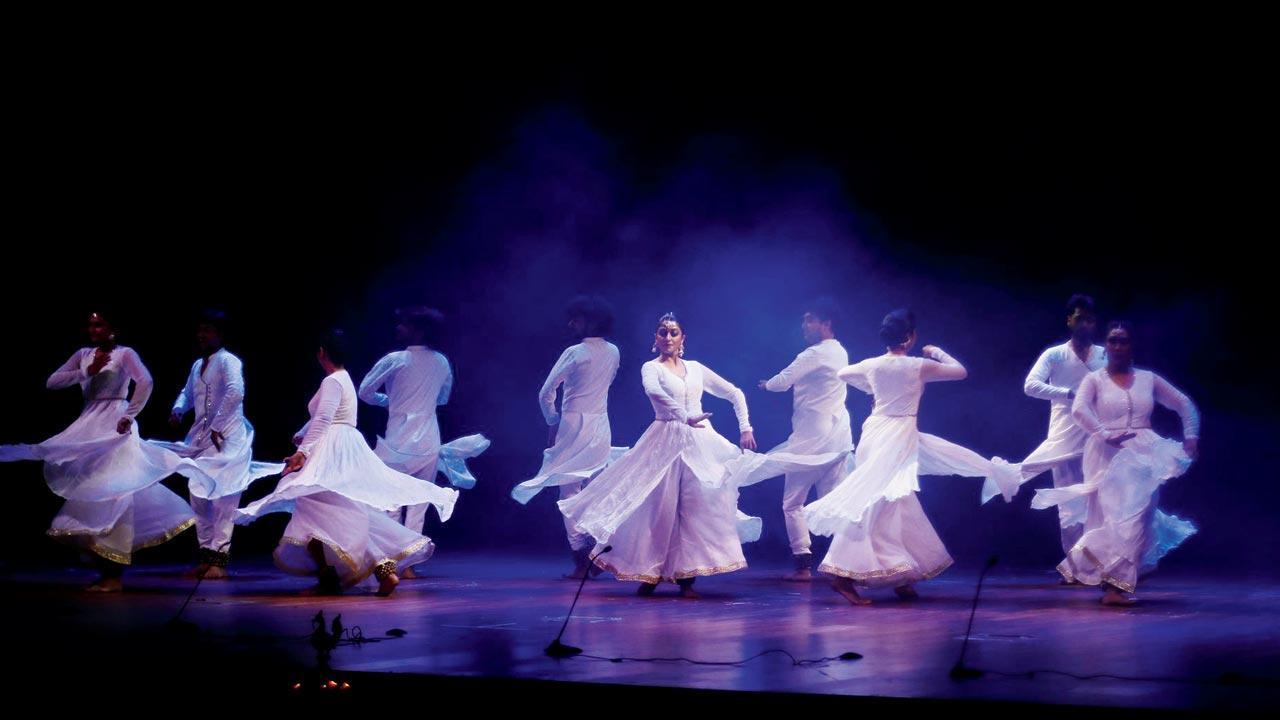It’s been a year like no other for Kathak exponent-choreographer Kumudini Lakhia, who beat COVID at 91 and made peace with virtual drawing room dance lessons. Aching to return to her dance school, she says large empty spaces offer a dancer energy that’s irreplaceable

Lakhia started the practice of making her performers wear white on stage, not seen before in Kathak performances, and insisted on neat hairdos and minimal ornamentation on the dancer’s body. Pics Courtesy Kadamb Centre For Dance
Next month, Kumudini Lakhia will be conducting an online workshop on abhinaya or expression, an aspect of dance that she feels cannot be taught. The dancer must lend a personal experience of joy and pain to the performance for the expressions to feel authentic. Lakhia like so many classical exponents has worked to adapt to the online format in the past year, holding virtual sessions like these, though she is far from getting comfortable with it. “I belong to the old school and like to have the student before me,” she says over the phone from her home in Ahmedabad, admitting to how much she has missed teaching in person. Lakhia, who turned 91 last week, continues to make the rounds of her dance academy, Kadamb. Unlike there, abhinaya is difficult to explain online. “People live in small spaces. You start teaching and suddenly you see a bed or a dining table getting in the way. It’s distracting. To be able to give, which you have to in abhinaya, you need empty space around to draw energy from,” she explains.
ADVERTISEMENT
Lakhia recently recovered from Covid-19. “My doctor called me a fighter,” she says. “To survive a Covid attack at my age is not unusual, but my blood was clotting,” she explains, pointing out that this last bit had her doctors fairly worried for a while. “But I have recovered completely and am fit again,” she reassures.
Lakhia is well-known for her abstract choreographies, focused on conveying moods rather than stories. She traces her earliest inspirations for this style to painting, architecture and poetry. She credits artists like MF Husain and VS Gaitonde, her interest in the ways in which architects used shapes and space, and her frequent visits to the National Institute of Design (NID) to pore over books on woodwork and carpentry. “When I was learning, everything was about Radha-Krishna, Shiva-Parvati, Ram-Sita. But there are other people in the world too!” she laughs. Tired of the religious themes that dominated the compositions of the time, Lakhia broke away towards a more abstract style that absorbed varied artistic influences, designing simple costumes in earthy shades and minimal jewellery, and having music director Atul Desai compose especially for her. One of the first pieces she choreographed was Dhabkar (Pulse) for a performance in Delhi, where her dancers and the musicians wore white, highly unusual for the time, and performed on different levels on the stage playing with perspective. “That was my first attempt to get around the format of a [classical] dance form and design it for my own imagination,” she says.
Also Read: India reports 8.8K black fungus cases; Amphotericin vials allocated
Kumudini Lakhia trained under a number of gurus and in a variety of styles, drawing influences from art forms like painting, architecture and poetry for her later abstract compositions. She says abhinaya is the toughest to teach virtually to students
Lakhia trained under a number of gurus, the most influential among them being Shambhu Maharaj of the Lucknow school of Kathak. She also toured extensively through Europe and America with dancer and choreographer Ram Gopal’s company, learning important practices of stage discipline and presentation, and being exposed to a variety of performative styles in those vital years.
Her own teaching career began, she recalls, in a small office room with just three students. It was her zeal that would eventually lead her to set up her centre for dance in the 1960s, which her earnings from her international performances helped fund.
Also Read: Covid-19: Not just people, we must test our water
Kumudini Lakhia
Kadamb became a second home for many in the years to come. Rupanshi Kashyap, one of Lakhia’s senior disciples, graduated in dance upon Lakhia’s insistence, trained at the academy for close to two decades and is now one of its teachers. She remembers how as a child she would visit Kadamb with her mother, who was then a student there and grew to love the place even before it became a veritable place of worship. The morning sessions were held by Lakhia, a practice followed right until the pandemic, while the other teachers at the school trained students in the basics in the evenings. Kashyap speaks of Lakhia as a teacher who appreciates hard work and attentiveness in her students and describes her process of choreography as deeply accommodating. “It taught us how to treat a dancer’s body, how to respect the instrument that is being used to create the moving images she had in mind,” she says. She speaks in particular of a piece titled Suvarna, commissioned for a show in Brazil and composed by Lakhia in India’s 50th year of independence, as one that has stayed with her over the years. The crux of Lakhia’s wordless choreographies and their continuing appeal, she feels, lies in the fact that they remain open to interpretation. “Even her pieces from the ’70s are still so modern and relevant today.”
Also Read: How Mumbai school bus staffs are struggling to make ends meet amid Covid-19
 Subscribe today by clicking the link and stay updated with the latest news!" Click here!
Subscribe today by clicking the link and stay updated with the latest news!" Click here!






